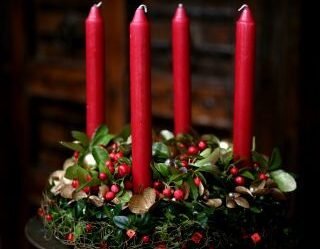Contenus
ToggleIn short
Avent, du latin adventus arrivée, est la période qui couvre quelques semaines précédant Noël, quatre dans la tradition de l’Église latine. Depuis l’instauration de ce temps liturgique, par analogie au carême, par le pape Saint Grégoire le Grand, l’avent représente la période où l’on se prépare principalement à la Parousie, la venue du Christ dans la gloire à la fin des temps; et dans les derniers jours précédant Noël, à faire mémoire de l’Incarnation de Jésus, de sa naissance corporelle.

Dimanches de l'Avent
Dans les Églises utilisant le calendrier grégorien, l’avent débute le quatrième dimanche avant Noël et marque le début de l’année liturgique. L’avent commence donc, au plus tôt, le 27 novembre et, au plus tard, le 3 décembre et se termine le 24 décembre.
Les Églises orthodoxes et les Églises catholiques orientales observent une période de jeûne et de pénitence qui équivaut à l’avent, mais ce terme n’y est utilisé que depuis peu : ce temps liturgique de préparation à Noël se nomme traditionnellement le Jeûne de la Nativité. Ce jeûne dure 40 jours alors que, dans le rite latin, il est de quatre semaines, et de six semaines dans les rites ambrosien et mozarabe.
Dans le catholicisme, la période de l’avent célèbre le triple avènement du Christ : sa naissance à Bethléem, sa venue dans le cœur des hommes de tout temps, et son retour à la fin des temps. Dès le début de l’année liturgique, la triple référence au passé, au présent et à l’avenir est présente.
L’Église catholique n’observe plus ni jeûne ni abstinence pendant l’avent. L’office connaît les mêmes rites que le carême, à peu de chose près, et un esprit de pénitence y préside. La couleur liturgique est le violet mais elle était autrefois le noir. Le dimanche de Gaudete (3e dimanche) est célébré en rose : on approche de la Nativité et le blanc utilisé à Noël rayonne jusque dans le violet.
Les noces y sont prohibées, jusqu’à l’Épiphanie ; cela s’explique par le fait que primitivement la fête de la naissance de Jésus se célébrait le 6 janvier, sous le nom de Théophanie.
Inspirée d’une tradition de l’Allemagne du XVIe siècle, la couronne de l’avent est inventée, en 1839, par le pasteur Johann Heinrich Wichern afin de contenir l’impatience des enfants qu’il éduque ; il fabrique alors une couronne de bois, avec dix-neuf petits cierges rouges et quatre grands cierges blancs. Chaque matin, un petit cierge est allumé et, chaque dimanche, c’est un grand cierge ; la coutume n’a retenu que les grands.
La tradition du calendrier de l’avent semble prendre sa source en Germany, au XIXe siècle, lorsque des familles protestantes ont coutume de mettre, chaque matin, une image pieuse commentant une phrase de l’Évangile ou une incitation à faire une bonne action, au mur, et cela durant vingt-quatre jours, afin de canaliser l’impatience des enfants jusqu’au jour de Noël.
Les images deviennent de plus en plus somptueuses à partir des années 1850 et sont même parfois éditées sous forme de triptyques, avec des volets à ouvrir pour découvrir le dessin central. C’est cette idée d’images masquées qui donna celle du calendrier de l’avent. Le calendrier est alors composé d’un ensemble de 24 fenêtres que l’on ouvre chaque jour pour découvrir une image.
Le calendrier de l’avent commence habituellement le 1er et se termine le 24 décembre, ce qui ne correspond pas exactement au temps de l’avent, qui commence le quatrième dimanche avant Noël. Certains calendriers, plus proches de l’idée originelle, ne comportent pas systématiquement 24 jours, mais un nombre de jours variant entre 22 et 28 selon la durée de l’avent.
Social networks
Aujourd’hui, les chrétiens commencent l’Avent. Il débute le quatrième dimanche avec Noël. Ce temps célèbre le triple avènement du Christ : sa naissance à Bethléem, sa venue dans le cœur des hommes de tout temps, et son retour à la fin des temps. #mythologie #mythe #legende #calendrier #catholique #chretien #avent
Picture
